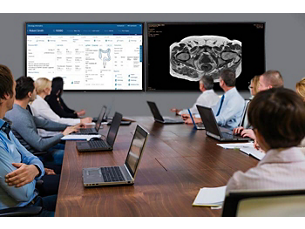- Lung Cancer Screening Manager
-
Lung Cancer Screening Manager
The Lung Cancer Screening Manager utilizes a defined and proven set of steps to ensure the proper follow-up of screening examinations and diagnostic testing is completed on time. Results are then communicated to the participant, their primary care physician, and can be uploaded and documented in the Electronic Medical Record (EMR). - Smooth Integration
-
Smooth integration
As lung cancer screening patients are progressing through their annual screenings and diagnostic follow-ups, the system captures required and optional data elements. Required data can be easily uploaded to the American College of Radiology (ACR) Lung Cancer Screening Registry (LCSR). With Integration into the EMR, data population within the Lung Cancer Screening Manager is fast and efficient, helping to reduce administrative tasks, and allowing more time for patient care. - Incidental Nodule Manager
-
Incidental Nodule Manager
Philips Incidental Nodule Manager helps identify suspicious pulmonary findings in patients that might otherwise be overlooked. It uses Natural Language Processing to mine radiology reports for the relevant keywords to trigger referral for follow up, management and treatment. Using multiple methods for analysis and checking, Philips aims to help ensure patients are not lost to follow up. - Automated patient management tools
-
Automated patient management tools
The system has the ability to enroll patients in a management protocol with automated notifications, reminders and status updates. Users can monitor and manage patient status using convenient and secure web-based tools. - Operational analytics
-
Operational analytics
Operational analytics can help clinicians automatically capture the right dataand insightsto help stay ahead of potential problems while managing lung cancer screening and incidental findings programs. Lung cancer management can be complex. By collecting, viewing, and integrating data around diagnostic yield, cancer detection and outcomes we may simplify the workflow. Insight can also inform scientific research by capturing and sharing information around distributions of demographic data, tumors cell types and diagnostics. - Collaborative multidisciplinary lung cancer tumor boards
-
Collaborative multidisciplinary lung cancer tumor boards
The Multidisciplinary Team Orchestrator helps streamline clinical decision making by giving multidisciplinary clinical teams the tools to schedule, prepare and manage tumor board reviews. It securely integrates clinical patient information from disparate sources including EMRs, lab systems, pathology, radiology, and genomics and creates one rich dashboard so clinicians can view their patient’s history and have quick access to relevant radiology and pathology images and reports. Its cloud-based implementation allows for multiple users to view patient’s data concurrently, and access wherever.
Lung Cancer Screening Manager

Lung Cancer Screening Manager

Lung Cancer Screening Manager
Smooth integration

Smooth integration

Smooth integration
Incidental Nodule Manager

Incidental Nodule Manager

Incidental Nodule Manager
Automated patient management tools

Automated patient management tools

Automated patient management tools
Operational analytics

Operational analytics

Operational analytics
Collaborative multidisciplinary lung cancer tumor boards

Collaborative multidisciplinary lung cancer tumor boards

Collaborative multidisciplinary lung cancer tumor boards
- Lung Cancer Screening Manager
- Smooth Integration
- Incidental Nodule Manager
- Automated patient management tools
- Lung Cancer Screening Manager
-
Lung Cancer Screening Manager
The Lung Cancer Screening Manager utilizes a defined and proven set of steps to ensure the proper follow-up of screening examinations and diagnostic testing is completed on time. Results are then communicated to the participant, their primary care physician, and can be uploaded and documented in the Electronic Medical Record (EMR). - Smooth Integration
-
Smooth integration
As lung cancer screening patients are progressing through their annual screenings and diagnostic follow-ups, the system captures required and optional data elements. Required data can be easily uploaded to the American College of Radiology (ACR) Lung Cancer Screening Registry (LCSR). With Integration into the EMR, data population within the Lung Cancer Screening Manager is fast and efficient, helping to reduce administrative tasks, and allowing more time for patient care. - Incidental Nodule Manager
-
Incidental Nodule Manager
Philips Incidental Nodule Manager helps identify suspicious pulmonary findings in patients that might otherwise be overlooked. It uses Natural Language Processing to mine radiology reports for the relevant keywords to trigger referral for follow up, management and treatment. Using multiple methods for analysis and checking, Philips aims to help ensure patients are not lost to follow up. - Automated patient management tools
-
Automated patient management tools
The system has the ability to enroll patients in a management protocol with automated notifications, reminders and status updates. Users can monitor and manage patient status using convenient and secure web-based tools. - Operational analytics
-
Operational analytics
Operational analytics can help clinicians automatically capture the right dataand insightsto help stay ahead of potential problems while managing lung cancer screening and incidental findings programs. Lung cancer management can be complex. By collecting, viewing, and integrating data around diagnostic yield, cancer detection and outcomes we may simplify the workflow. Insight can also inform scientific research by capturing and sharing information around distributions of demographic data, tumors cell types and diagnostics. - Collaborative multidisciplinary lung cancer tumor boards
-
Collaborative multidisciplinary lung cancer tumor boards
The Multidisciplinary Team Orchestrator helps streamline clinical decision making by giving multidisciplinary clinical teams the tools to schedule, prepare and manage tumor board reviews. It securely integrates clinical patient information from disparate sources including EMRs, lab systems, pathology, radiology, and genomics and creates one rich dashboard so clinicians can view their patient’s history and have quick access to relevant radiology and pathology images and reports. Its cloud-based implementation allows for multiple users to view patient’s data concurrently, and access wherever.
Lung Cancer Screening Manager

Lung Cancer Screening Manager

Lung Cancer Screening Manager
Smooth integration

Smooth integration

Smooth integration
Incidental Nodule Manager

Incidental Nodule Manager

Incidental Nodule Manager
Automated patient management tools

Automated patient management tools

Automated patient management tools
Operational analytics

Operational analytics

Operational analytics
Collaborative multidisciplinary lung cancer tumor boards

Collaborative multidisciplinary lung cancer tumor boards

Collaborative multidisciplinary lung cancer tumor boards
Specifications
- Browser
-
Browser Internet Explorer - Internet Explorer 11.0
-
- Hardware requirements
-
Hardware requirements Processor - Dual Xeon 4 (or higher)
Processor Speed - 3GHz processor
RAID Memory Cache - RAID 1
RAM - 16 GB
Disk Array - 500GB hard disk [15K RPM hard disk (x2)]
Power Supply - Dual
Operating System - 64bit Hardware/64bit
Monitor - Display: 1024 x 768 Super VGA and with Video Card
LAN - 1 Gbps
Keyboard - English Only
-
- Software requirements
-
Software requirements Windows Server - 2016 (64 bit) (recommended), Windows Server 2012 R2 (64 bit)
.NET Framework - 4.7.2 and above
Rhapsody - 6.4.1
Supported databases, either local or remote - MS SQL 2012 - 64 bit – SP4
- MS SQL 2014 - 64 bit – SP3
- MS SQL Server 2016 – SP2 (recommended)
IIS (required for DECG Solution feature otherwise optional) - For Windows Server 2016 use IIS 10.0
- For Windows Server 2012 R2 use IIS 8.0
PowerShell - 4.0 and above
-
- Browser
-
Browser Internet Explorer - Internet Explorer 11.0
-
- Hardware requirements
-
Hardware requirements Processor - Dual Xeon 4 (or higher)
Processor Speed - 3GHz processor
-
- Browser
-
Browser Internet Explorer - Internet Explorer 11.0
-
- Hardware requirements
-
Hardware requirements Processor - Dual Xeon 4 (or higher)
Processor Speed - 3GHz processor
RAID Memory Cache - RAID 1
RAM - 16 GB
Disk Array - 500GB hard disk [15K RPM hard disk (x2)]
Power Supply - Dual
Operating System - 64bit Hardware/64bit
Monitor - Display: 1024 x 768 Super VGA and with Video Card
LAN - 1 Gbps
Keyboard - English Only
-
- Software requirements
-
Software requirements Windows Server - 2016 (64 bit) (recommended), Windows Server 2012 R2 (64 bit)
.NET Framework - 4.7.2 and above
Rhapsody - 6.4.1
Supported databases, either local or remote - MS SQL 2012 - 64 bit – SP4
- MS SQL 2014 - 64 bit – SP3
- MS SQL Server 2016 – SP2 (recommended)
IIS (required for DECG Solution feature otherwise optional) - For Windows Server 2016 use IIS 10.0
- For Windows Server 2012 R2 use IIS 8.0
PowerShell - 4.0 and above
-
Related products
Alternative products
- Product not available for sale in all countries. Please contact your sales representative to ascertain availability in your country.

